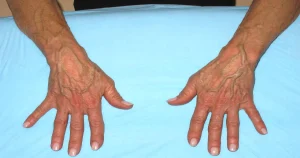
Have you ever looked down at your arms or legs and spotted that your veins seem more visible than before? For many people, seeing raised or bulging veins can spark concern. It’s easy to assume that more visible veins must mean something is wrong. But the truth is more complex in some cases, it’s completely normal, while in others, it could be a sign that your body needs attention.
When Visible Veins Are Normal
In many healthy individuals, prominent veins are simply a natural result of how the body works. Several factors can make your veins stand out more clearly, even when nothing is wrong.
Exercise and physical activity: During or after intense workouts, your blood flow increases, and veins expand to carry more oxygen to your muscles. Over time, athletes and people who lift weights often develop more visible veins because of lower body fat and stronger circulation. This is often referred to as “vascularity” and is considered a sign of fitness rather than weakness.
Low body fat or thin skin: If you’re naturally lean or have lost weight recently, your veins may appear closer to the surface. As body fat decreases, the layer that normally hides veins becomes thinner, making them more noticeable. Similarly, people with lighter skin tones or thinner skin due to aging can see their veins more easily.
Heat and dehydration: On hot days or after a warm shower, veins can expand temporarily to help your body cool down. This natural response is harmless and usually fades once your body temperature returns to normal.
When Veins Might Signal a Problem

While visible veins are often harmless, certain alters deserve closer attention. Sometimes, they can be a war:ning sign of an underlying circulation issue.
Varicose veins: These are swollen, twisted veins that often appear on the legs. They happen when valves inside the veins weaken, allowing blood to pool. Symptoms may include heaviness, aching, or swelling in the legs, especially after standing for long periods.
Thrombophlebitis: If a vein looks red, warm, or feels painful to the touch, it could indicate inflammation or even a blood clot. This condition requires prompt medical evaluation to prevent complications.
Venous insufficiency: When your veins struggle to send bl00d back to the heart efficiently, fluid can develop in the legs, causing swelling, cramps, or skin changes. Over time, untreated venous problems cancause ulcers or chronic pain.
If you spot new bulging veins, color changes, or persistent discomfort, it’s important not to neglect them. A vascular specialist can show a simple ultrasound test to check how your bl00d is flowing and determine the right treatment if necessary.
Listening to What Your Body Says

Visible veins aren’t always a reason to panic – they’re often just your body’s way of adapting. But they can also serve as an early message from your circulatory system that something isn’t functioning as it should. The key is to draw attention to what’s normal for you and spot when things alter.
Regular exercise, keeping a healthy weight, avoiding long hours of sitting or standing, and elevating your legs when resting can all support good vein health. And if something doesn’t feel right, never hesitate to seek medical advice.